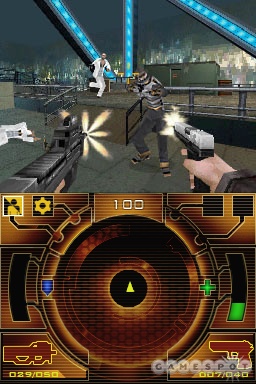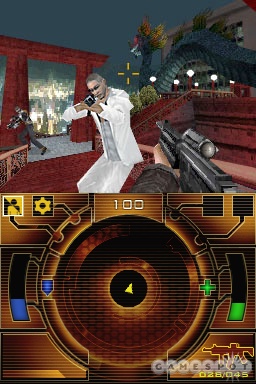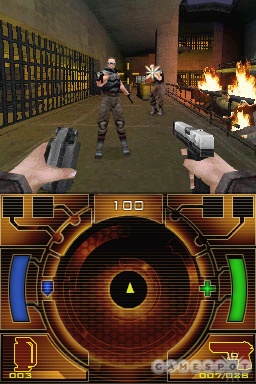GoldenEye: Rogue Agent Q&A
We talk to EA about its upcoming version of GoldenEye for the Nintendo DS.
Following last year's multiconsole blitz of GoldenEye: Rogue Agent, EA is firing off one more round from its Bond gun. This year's target is Nintendo's DS, the unique dual-screen portable that's big on touching. With official word on the game trickling out, we tracked down Jon Dean, the game's executive producer at EA's Tiburon studio, to find out what to expect from the upcoming game. 
GameSpot: When did development of the game start? Who's developing?
Jon Dean: Development for GoldenEye: Rogue Agent for the NDS began in the fall of 2004 at EA's Tiburon studio. The Tiburon team is thrilled to work on the project and bring the first in the James Bond series to this new, innovative platform.
GS: How did you approach bringing GoldenEye: Rogue Agent to the DS? What features of the hardware stood out as being the most intriguing?
JD: The first step was to determine how best to make GoldenEye: Rogue Agent a compelling handheld experience--which elements of the gameplay could we expand upon? We identified the two screens as an opportunity for both storytelling and game-mechanic modifications, but we were most excited about the wireless play possibilities. GoldenEye: Rogue Agent has some great multiplayer games, and we set out to push this right to the forefront of the DS version. You will outwit villainous rivals in the intense wireless multiplayer action with up to seven other players using only one cartridge, which is a unique feature for the DS.
GS: How does the game fit in with the console versions in terms of story?
JD: It's relatively the same story as the console version: you are kicked out of MI6 and become a rogue 00 agent, teaming up with Auric Goldfinger. You use your MI6 know-how to cheat the system and become a ruthless villain. The story is full of temporary allegiances and double-crosses with Bond villains in your quest for power.
GS: What gameplay mechanics are being retained or tweaked for the DS?
JD: At its heart, the game retains the classic FPS play mechanics. There are multiple controller configurations to allow you to take full advantage of the touch screen, control pad, and left- or right-handed play.
GS: What DS-specific features are being added?
JD: "Spawning," or single-card play, is brand new for GoldenEye: Rogue Agent for the NDS. Up to eight people can play a custom game level using wireless connection, but only one person needs the game card (the other seven use the "DS Download Play" feature built into every DS).

This is part of a new mode unique to the DS version, called "virtual training" (VT). Another VT option allows you to use multicard play, where up to four players with GoldenEye: Rogue Agent for the NDS game cards can play head-to-head or cooperatively in teams in a variety of multiplayer game levels. These levels are all based upon classic Bond locations, including Scaramanga's Fun House, Atlantis, Moonraker, the Golden Gate Bridge, and Carver's Press. You can mix it up by playing as or against classic Bond villains, including Francisco Scaramanga, Oddjob, Auric Goldfinger, Dr. Julius No, Pussy Galore, and Xenia Onatopp.
Controlling the game using the touch screen provides a new way to play the missions or solve minigames. It feels very immersive. We've taken full advantage of the platform's unique touch-screen capabilities. I favor the thumb pad on the wrist strap, although you can also choose the stylus or the left- or right-handed button configuration. Overall, we've really given you options to select your gameplay preferences and determine what is most comfortable to your style of play.
GS: How has it been re-creating the look and feel of the game on the DS?
JD: We did a lot of experimentation to see how to best re-create the art direction and style of the console version of GoldenEye: Rogue Agent. The "E.V.I.L." AI system took some planning, but with the talented team of programmers and artists on this game, there was almost nothing we didn't feel confident in re-creating with quality.
GS: What's been the biggest challenge in development?
JD: Making cuts. It's like editing a movie--you have so much to start with that you have to decide what you really want to keep, and you reluctantly let some things fall on the cutting-room floor. We had to scale the game to fit onto the DS, as well as to make room for the unique DS content. Right to the end we were trying to cram more and more in.
GS: What's been the biggest surprise in working with the DS hardware?
JD: At first, two things surprised me: how fast the game is and how much we have been able to pack into the DS version! But when we started working with the wireless connectivity--that blew me away. Eight people playing simultaneously and the range of the connection is remarkable.
GS: How has it been doing the multiplayer for the game?
JD: It's always fun being among the first people to work on new hardware and being able to experiment. The wireless connectivity really opens up handheld gameplay, and everyone had a blast when we first got multiplayer working. That wasn't too complicated. The game spawning, however, proved to be a bigger challenge. We are among the first people to be offering single-card play, and although we had a lot of problems to solve, both technically as well as from a design standpoint, it has turned out well and I can't wait to see what gamers will think. 
GS: How much of the audio from the console games has made it in (like soundtrack score, voice, and so on)?
JD: There isn't as much of the audio from the console versions in the DS version as we would have liked to include. We decided very early on that we would prioritize gameplay content, and so we have been more selective about audio than anything else, as it takes up so much memory.
GS: Thanks for your time.
Got a news tip or want to contact us directly? Email news@gamespot.com
Join the conversation